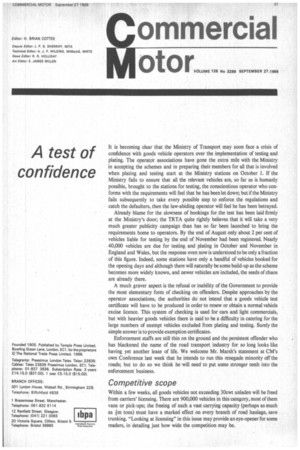A test of confidence
Page 39

If you've noticed an error in this article please click here to report it so we can fix it.
It is becoming clear that the Ministry of Transport may soon face a crisis of confidence with goods vehicle operators over the implementation of testing and plating. The operator associations have gone the extra mile with the Ministry in accepting the schemes and in preparing their members for all that is involved when plating and testing start at the Ministry stations on October 1. If the Ministry fails to ensure that all the relevant vehicles are, so far as is humanly possible, brought to the stations for testing, the conscientious operator who conforms with the requirements will feel that he has been let down; but if the Ministry fails subsequently to take every possible step to enforce the regulations and catch the defaulters, then the law-abiding operator will feel he has been betrayed.
Already blame for the slowness of bookings for the test has been laid firmly at the Ministry's door; the TRTA quite rightly believes that it will take a very much greater publicity campaign than has so far been launched to bring the requirements home to operators. By the end of August only about 2 per cent of vehicles liable for testing by the end of November had been registered. Nearly 40,000 vehicles are due for testing and plating in October and November in England and Wales, but the response even now is understood to be only a fraction of this figure. Indeed, some stations have only a handful of vehicles booked for the opening days and although there will naturally be some build-up as the scheme becomes more widely known, and newer vehicles are included, the seeds of chaos are already there.
A much graver aspect is the refusal or inability of the Government to provide the most elementary form of checking on offenders. Despite approaches by the operator associations, the authorities do not intend that a goods vehicle test certificate will have to be produced in order to renew or obtain a normal vehicle excise licence. This system of checking is used for cars and light commercials, but with heavier goods vehicles there is said to be a difficulty in catering for the large numbers of exempt vehicles excluded from plating and testing. Surely the simple answer is to provide exemption certificates.
Enforcement staffs are still thin on the ground and the persistent offender who has blackened the name of the road transport industry for so long looks like having yet another lease of life. We welcome Mr. Marsh's statement at CM's own Conference last week that he intends to run this renegade minority off the roads; but to do so we think he will need to put some stronger teeth into the enforcement business.
Competitive scope
Within a few weeks, all goods vehicles not exceeding 30cwt unladen will be freed from carriers' licensing. There are 900,000 vehicles in this category, most of them vans or pick-ups; the freeing of such a vast carrying capacity (perhaps as much as lin tons) must have a marked effect on every branch of road haulage, save trunking. "Looking at licensing" in this issue may provide an eye-opener for some readers, in detailing just how wide the competition may be.
































































































































































































